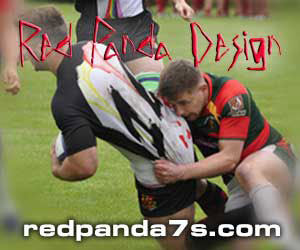Violent Conduct in Rugby

Check out Red Panda 7s for our latest range of caps
Rugby is a highly physical game and there is a fine line between fair physical play and violence. With the recent events involving Chris Aston and Manu Tuilagi I thought I'd look into whether there is too much violence and how this is being controlled within the game.
Tuilagi landed three big punches on Aston that caused him to need stitches. This wasn't unprovoked as Aston pushed Tuilagi. Surely though a push doesn't warrant this reaction. In this instance both players were handed yellow cards.
For the latest stash for your rugby team - from caps to bags and bespoke teamwear, check out Red Panda 7s
"Chris Ashton did go over and give him a push, but you cannot react with three punches to the head without a red card," commented a surprisingly restrained Saints boss Jim Mallinder.
For the latest stash for your rugby team - from caps to bags and bespoke teamwear, check out Red Panda 7s
Need a new t-shirt? Red Panda 7s can help!

www.redpanda7s.com - designs that think outside the box
In this case the debate is as much if not more about the punishment rather than the violence. The linesman instructed the referee of what happen and unfortunately he got it wrong. It could be said that what is right and wrong in a physical sport is opinion but the linesman report said that Aston struck Tuilagi which just didn't happen. If he was sent off it could have changed the outcome of the game as Northampton would have had a large advantage with 50 minutes left to play. Manu was cited and later received a 5 week ban for striking another player with the hand, arm or fist. Banning him for subsequent games is correct but this is little consolation to Northampton now.
This event raises various arguments about violence in rugby. As a player myself, I was always taught that retaliation was worse and Tuilagi definitely retaliated. Aston wasn't innocent in this but a sin-bin for a push does sound enough punishment. This posses the question of how instances like this should be managed immediately and long term.
The issue of these types of incidences has raised enough concern for studies to be compiled. Researchers from Liverpool John Moores University insist that referees should take firm action against those committing violent offences.
An examination of the level of violent offences in 30 rugby matches, from 1973 through the years, has found that fewer violent offences are committed overall, but those they do commit are getting more and more dangerous. The researchers found a decline in "punching", "late/high tackles", "obstruction" and "butting" - but an increase in "foot strike", or stamping on a player on the ground, a particularly dangerous offence.
The much worrying findings are that almost 80 per cent of all violent offences analysed went unpunished, and argue that referees should be firmer. "Referees are tempted to keep the game fluid, but by turning a blind eye to offences, they are tempting players to commit them," said Dr Peiser.
David Glaves argued: "Players are increasingly more powerful and athletic, resulting in a faster game. Recently this has contributed to several incidents of players receiving particularly horrific injuries.

"Because of these incidents there is a growing belief that the overall level of violence in rugby has drastically increased, although the opposite is true."
So these findings show that the number of incidences is decreasing but the severity is increasing. This can't be good and in my eyes is not an improvement as surely more long term injuries are occurring.
Recently there have definitely been more reported serious injuries caused intentionally. Gavin Quinnell permanently lost the sight in his left eye following an incident during Llanelli's Premiership game against Cross Keys. Clarence Harding, an amateur player, was playing in a cup clash between local rivals in Kent when he was gouged and left blind in one eye.
Eye gauging is just one of the violent acts that seem to have risen in rugby. With the increase in cameras at the top level of rugby you are going to be spotted and cited for throwing a punch even if you do it behind the back of the ref, an eye gouge needs no backswing but is as effective if not more damaging. Because it is hard to police the punishment has to be severe and there have been some high profile large bans.
Mark Cueto received 9 weeks, Schalk Burger received 8 weeks, Dylan Hartley who was banned for 26 weeks in 2007 and Julien Dupuy received a 24 week ban.
As you can see though their length does vary, which is worrying. In the case of Cueto, Christian Day the player he was alleged to gouge stuck up for him and his previous good record counted for him. This I can understand, it may have been an accident and he was backed but also received a long ban but not as long as others. Schalk Burger received a shorter ban in a clearer cut case. He is clearly seen purposely gauging Luke Fitzgerald's eye.
Hartley and Dupuy were banned three times this amount. The punishment has to be consistent as a heavy deterrent for a cowardly act.
An increase in violent acts is not only restricted to eye gauging and at the top level of the game. The amount of cameras may make it easier to spot offenders after the game but other offences are still on the rise and one particular case has rocked rugby in other ways as well. If these acts were done away from the pitch they would be illegal and face criminal proceedings.
Back in 2006 Halifax played host to Redruth. Redruth second row Richard punched Halifax prop Andrew Garvil. Carroll broke Garvil's eye socket, leaving him requiring orbital surgery, yet he only received a yellow card. The case was so serious Carroll was ordered to pay Garvil damages. Some people would argue that once you step on a rugby field you accept the risk of injury even from foul play. This is true but surely only up to a certain point especially at semi pro and amateur level, everyone has to go to work on Monday. So if a player causing a serious injury that could effect their working life the player should be punished and the recipient is surely due compensation of some kind. This is one argument alone but the plot thickens.
At first the ruling did not find Redruth Rugby Club to be liable for the actions of its player. But that too changed when a High Court appeal overturned the original decision and ruled that the club was indeed responsible for what happened on the pitch. Redruth were ordered to pay £8,500 in damages and £30,000 in costs, setting a precedent that could reverberate through the world of rugby. Can a club really be held responsible for player's actions? Surely once a player walks on the field they are accountable for their own! If a club trained and had specific instructions to players to play in a certain dangerous way they are accountable but a one off incident must be down to the individual.
There has been another example where a player was punished away from rugby.
Wales and Bridgend player Chris Stephens, 25, admitted inflicting grievous bodily harm on a rival full-back. He was ordered to pay £2,000 compensation for punching an opponent so hard that he was forced to abandon his career.
Even though I feel that holding a club responsible for an incident is harsh we don't know what was said in court. If this was a precedent, clubs and players would be forced to be more careful as the ramifications of cases like this could be dreadful for the clubs and players sanctioned. This would surely reduce the cases of violence in the game.
Rugby is the exciting game because of its hard physical contact and it would be ruined if it was to be softened up. There has to be a limit were vigorous is overtaken by violent. There is no excuse for stamping, punching from behind or tackling neck-high. The laws are quite clear in what is and isn't allowed. This means more emphasis needs to lie on referees to police and punish for breaking these. At the top levels they have enough technology to help even with the hidden offences so consistency of punishment has to be the most important factor to discourage foul play. As we have discovered there have been higher punishments imposed for violent conduct. Although I hope these are not going to be regular, I hope that the threat may be enough to deter.
Overall violence in rugby does have to be addressed. It will always be part of the physical game we love just hopefully at a minimum.
To end I can show that rugby may be a violent game and the small minority may go over the mark but it still remains that unless serious injury is caused all is forgiven. This is perfectly represented by Chris Aston's reaction to the Tuilagi incident.
"I believe rugby is rugby and once rugby has finished and the whistle has gone, the whistle has gone.
"I'm not one for carrying on after the game; I know a few people I have wound up in the past have carried it on after the whistle but I don't think that is right; what has happened on the pitch should stay on the pitch if it was right or wrong and I shook his hand like anyone else."
This article was wrote by www.KooGa-Rugby.com

TalkingRugbyUnion recommends Red Panda 7s for all your rugby casual and teamwear requirements




